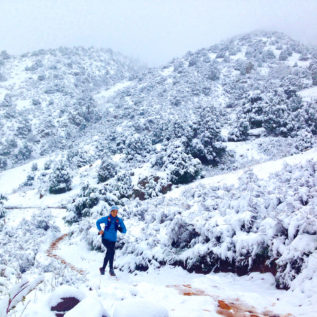You’re tired, you had to work late, it was two-for-one margaritas at your favorite bar. Stuff happens, but you can still stick to a solid training plan.
Trail Run Project Journal | September 2016
This story first appeared on Trail Run Project Journal. Read the original entry here.
Realistically, the unplanned happens, and sometimes that’s right in the middle of training season. But while prepping for the Leadville Marathon, I realized how important it was to just show up—even if I didn’t think I was going to be well-rested or perform my strongest. Doing so, I learned how my body operates, and cooperates,even in seemingly unideal circumstances. That includes checking off some miles in a blizzard.

Training for a June race, you’re almost guaranteed to experience a spring blizzard or two, especially in Colorado. When tumultuous weather aligned with my 16-mile run in April and 16 inches of snow fell, I fought the urge to curl up on the couch, rallied a few fellow runners, and we hit the trails in the Denver Foothills. We ran a figure eight loop that started with the Zorro Trail to Dinosaur Ridge.
At the top, we turned south on Dakota Ridge and descended to Red Rocks Trail. Fog danced over the snow-covered trail—until we reached the top of the plateau where the wind tore over with a nasty bite. By the time we regained Dinosaur Ridge, the trail was a slippery mud fest. After a brief pit stop at the cars to refuel, we finished with the Green Mountain Trail loop, where we experienced the real surprise. A harsh whiteout socked us in and two-foot-high snowdrifts covered the trail for a couple of miles. It sounds wild (and it was to an extent), but we all had the proper protective layers to cover our skin, block wind, and wick moisture. We all stayed dry and warm, and this crazy run ending up being a blast.
Friends on a snowy trail run make any amount of suffering fly by. Snow, mud, and wind can infinitely slow down the pace, but it’s also important to train in those conditions because you never know what might happen on race day.
Regardless of weather, soreness, motivation, or fatigue, it’s key to get out there and try. Here are four of the most common running excuses—and how to beat them:
1. “I’m tuckered out.” Think: Any amount of time on your feet counts, even if you’re slower than usual.
2. “Uck, heat.” Start super early; choose a shaded run; hydrate well beforehand; wear a hat, sunglasses, sunscreen; mix hydration powder into water (I prefer Scratch Labs); arrange aid stations.
3. “I might poop my pants.” The internal system has the potential to turn a 180. If you’re not feeling well at the start of a run, you might feel better after 10 miles. Regardless, all trail runners know that s*#% happens.
4. “Running just doesn’t sound fun today.” If I feel a lack of energy, mentally or physically, running is how I stoke my motivation. It may feel counterintuitive, but it takes practice and discipline to know the difference between mental or physical motivation and fatigue versus the need for recovery. Also, remembering all of the epic trails that are on my bucket list always inspires me to get out there.
